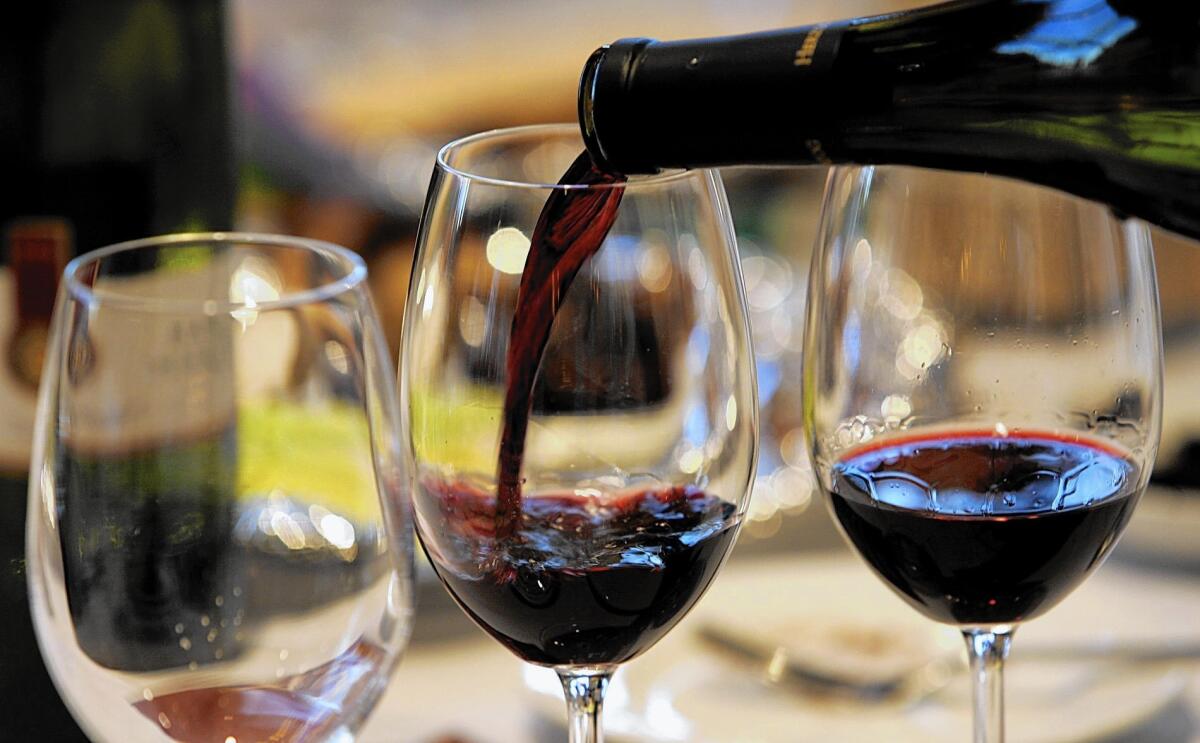Corkage fee helps put a cap on wine expenses

- Share via
One of the greatest sources of friction between restaurateurs and their wine-loving customers is the corkage fee — what they charge when you bring in a bottle of your own wine.
Wine lovers, who are aware of how much restaurants mark up wine above retail, can find prices on wine lists a jolt to the wallet. On the other hand, restaurateurs who have invested in hiring a sommelier and have spent considerable time and money putting together a serious list can view bringing wine in as a slight to their professionalism.
GUIDE: A look at corkage fees at L.A. restaurants
Why bring wine to a restaurant at all?
You may have a bottle or two you want to drink with great food that would show off the wine, not something everyone can prepare at home.
And many who bring wine are passionate restaurant-goers who just happen to have this one peculiarity: They like to bring their own wine. And they don’t mind paying a reasonable corkage fee.
“Those who do bring their own wine tend to be excited to have our food paired with their wine,” says Republique’s Taylor Parsons. “I take pride in serving every $36 bottle and every bottle of corkage with as much respect as we’d serve a $3,000 bottle. I don’t think service should be different based on how much money you spend.”
But, Parsons also points out, if someone comes in with a $10 wine and pays the $30 corkage, he can often find a much better wine on the list for that $40.
Sometimes wine lovers bring in a treasured bottle they’ve held on to for years. Bestia wine director Ryan Ibsen regards it as an honor when that happens. “Traditionally, that’s what bringing your own bottle to a restaurant with a great wine program meant,” he explains. “That’s a big difference between stopping off at Costco for a bottle of Caymus. At the end of day, honestly, I’m thrilled just to make people happy. If they bring a $7 bottle of wine and they want to pay $30 corkage, I’m happy to open it for them.”
Former Spago sommelier Kevin O’Connor, now co-owner of Lioco winery and a partner in the new Santa Monica restaurant Aestus, understands why a customer complains when he sees a wine marked up three times retail or even more.
“When you see the bottle you just bought in a wine shop for $20 or $30 at over $100 on a wine list, why wouldn’t you [choose to] pay corkage?” he says. “At Aestus, even for highly allocated wines, you’re going to be paying a two-times markup, which I think is fair.”
He also prices wines on a sliding scale: Markups are higher for less-expensive wines and lower for more valuable wines. The same goes with his corkage, normally $25, but for wines 10 years or older, it’s $10.
Caroline Styne says she sometimes has to explain why Lucques or AOC charges corkage at all. “We can’t just serve wine in a tumbler,” she says. “You’re using our expensive glassware. There’s the labor involved in serving the wine and in the washing and polishing of the glasses.
“I carry a $100,000 inventory at Lucques, and we try very hard to offer wines at a variety of price points, from $30 to $300, so people who don’t want to spend a lot on wine aren’t shut out.”
Like many restaurateurs, she waives the corkage on one bottle if a customer buys a bottle from the restaurant. That way the customer has the chance to discover something new and also drink that special bottle brought from home.
On the other hand, the restaurateur gets the corkage fee without ever having to buy or store the wine. It’s a win-win for both restaurant and wine lover.
GUIDE: A look at corkage fees at L.A. restaurants
irene.virbila@latimes.com
Follow me @sirenevirbilaMore to Read
Eat your way across L.A.
Get our weekly Tasting Notes newsletter for reviews, news and more.
You may occasionally receive promotional content from the Los Angeles Times.









